Ultrasonically Fabricated Beta-Carotene Nanoemulsion: Optimization, Characterization and Evaluation of Combinatorial Effect with Quercetin on Streptozotocin-Induced Diabetic Rat Model
Abstract
:1. Introduction
2. Materials and Methods
2.1. Materials
2.2. Assessment of β-Crt Solubility in Nanoemulsion Components
2.3. Selection of Surfactants
2.4. Selection of Co-Surfactants
2.5. Effect of Smix Mass Ratio
2.6. Preparation of β-Crt-Nanoemulsion(βC-NE)
2.7. Optimisation of βC-NE by Box-Behnken Design (BBD)
2.8. Determination of Globule Size (G.S.), Polydispersibility Index (PDI) and Zeta Potential (Z.P.)
2.9. Determination of Entrapment Efficiency (% E.E.)
2.10. Impact of Storage Condition on G.S. and PDI
2.11. In Vitro β-Crt Release Studies
2.12. Morphological Characterisation by Transmission Electron Microscope (TEM)
2.13. Animals
2.14. In-Vivo Pharmacokinetics Study
2.15. Induction of Diabetes and Animal Grouping
2.16. Measurement of Body Weight (B.W.), Blood Glucose Level (BGL), and Oral Glucose Tolerance Test (OGTT)
2.17. Analysis of Biochemical Parameters, Tissue and Oxidative Stress-Markers
2.18. Histopathological Analysis of Pancreas and Liver Tissue
2.19. Statistical Methods
3. Results
3.1. Selection of Nanoemulsion Components
3.2. Effect of Smix Mass Ratio
3.3. Optimisation of βC-NE by Box Behnken Design (BBD)
3.4. Impact of Storage Condition on G.S. and PDI of βC-NE
3.5. In Vitro Drug Release Study of βC-NE
3.6. Morphological Characterisation of βC-NE by TEM
3.7. In Vivo Pharmacokinetic Studies of βC-NE and βC-PD
3.8. Influence of βC-NE and βC-NE+QU-NE on Body Weight (B.W.)
3.9. Influence of βC-NE and βC-NE+QU-NE on Blood Glucose Level (BGL)
3.10. Influence of βC-NE and βC-NE+QU-NE on Oral Glucose Tolerance Test (OGTT)
3.11. Influence of βC-NE and βC-NE+QU-NE on Lipid Levels
3.12. Influence of βC-NE and βC-NE+QU-NE on Tissue Injury and Oxidative Stress Markers
3.13. Histopathology Hepatic and Pancreatic Cells
4. Conclusions
Author Contributions
Funding
Institutional Review Board Statement
Informed Consent Statement
Data Availability Statement
Acknowledgments
Conflicts of Interest
References
- Dhalaria, R.; Verma, R.; Kumar, D.; Puri, S.; Tapwal, A.; Kumar, V.; Nepovimova, E.; Kuca, K. Bioactive compounds of edible fruits with their anti-aging properties: A comprehensive review to prolong human life. Antioxidants 2020, 9, 1123. [Google Scholar] [CrossRef] [PubMed]
- Asemi, Z.; Alizadeh, S.A.; Ahmad, K.; Goli, M.; Esmaillzadeh, A. Effects of beta-carotene fortified synbiotic food on metabolic control of patients with type 2 diabetes mellitus: A double-blind randomized cross-over controlled clinical trial. Clin. Nutr. 2016, 35, 819–825. [Google Scholar] [CrossRef] [PubMed]
- Lin, D.; Xiao, M.; Zhao, J.; Li, Z.; Xing, B.; Li, X.; Kong, M.; Li, L.; Zhang, Q.; Liu, Y.; et al. An Overview of Plant Phenolic Compounds and Their Importance in Human Nutrition and Management of Type 2 Diabetes. Molecules 2016, 21, 1374. [Google Scholar] [CrossRef] [PubMed]
- Dhanya, R.; Arya, A.D.; Nisha, P.; Jayamurthy, P. Quercetin, a Lead Compound against Type 2 Diabetes Ameliorates Glucose Uptake via AMPK Pathway in Skeletal Muscle Cell Line. Front. Pharmacol. 2017, 8, 336. [Google Scholar] [CrossRef]
- Coskun, O.; Kanter, M.; Korkmaz, A.; Oter, S. Quercetin, a flavonoid antioxidant, prevents and protects streptozotocin-induced oxidative stress and β-cell damage in rat pancreas. Pharmacol. Res. 2005, 51, 117–123. [Google Scholar] [CrossRef]
- Richter, E.A.; Hargreaves, M. Exercise, GLUT4, and skeletal muscle glucose uptake. Physiol. Rev. 2013, 93, 993–1017. [Google Scholar] [CrossRef]
- Vessal, M.; Hemmati, M.; Vasei, M. Antidiabetic effects of quercetin in streptozocin-induced diabetic rats. Comp. Biochem. Physiol.—C Toxicol. Pharmacol. 2003, 135, 357–364. [Google Scholar] [CrossRef]
- Donhowe, E.G.; Flores, F.P.; Kerr, W.L.; Wicker, L.; Kong, F. Characterization and in vitro bioavailability of β-carotene: Effects of microencapsulation method and food matrix. LWT—Food Sci. Technol. 2014, 57, 42–48. [Google Scholar] [CrossRef]
- Shi, G.J.; Li, Y.; Cao, Q.H.; Wu, H.X.; Tang, X.Y.; Gao, X.H.; Yu, J.Q.; Chen, Z.; Yang, Y. In vitro and in vivo evidence that quercetin protects against diabetes and its complications: A systematic review of the literature. Biomed. Pharmacother. 2019, 109, 1085–1099. [Google Scholar] [CrossRef]
- Riva, A.; Ronchi, M.; Petrangolini, G.; Bosisio, S.; Allegrini, P. Improved Oral Absorption of Quercetin from Quercetin Phytosome®, a New Delivery System Based on Food Grade Lecithin. Eur. J. Drug Metab. Pharmacokinet. 2019, 44, 169–177. [Google Scholar] [CrossRef]
- Kumar, M.; Bishnoi, R.S.; Shukla, A.K.; Jain, C.P. Techniques for formulation of nanoemulsion drug delivery system: A review. Prev. Nutr. Food Sci. 2019, 24, 225–234. [Google Scholar] [CrossRef]
- Kabri, T.; Arab-tehrany, E.; Belhaj, N.; Linder, M. Physico-chemical characterization of nano- emulsions in cosmetic matrix enriched on omega-3. J. Nanobiotechnology 2011, 9, 41. [Google Scholar] [CrossRef]
- Feeney, O.M.; Crum, M.F.; McEvoy, C.L.; Trevaskis, N.L.; Williams, H.D.; Pouton, C.W.; Charman, W.N.; Bergström, C.A.S.; Porter, C.J.H. 50 years of oral lipid-based formulations: Provenance, progress and future perspectives. Adv. Drug Deliv. Rev. 2016, 101, 167–194. [Google Scholar] [CrossRef]
- Komaiko, J.S.; Mcclements, D.J. Formation of Food-Grade Nanoemulsions Using Low-Energy Preparation Methods: A Review of Available Methods. Compr. Rev. Food Sci. Food Saf. 2016, 15, 331–352. [Google Scholar] [CrossRef]
- Aswathanarayan, J.B.; Vittal, R.R. Nanoemulsions and Their Potential Applications in Food Industry. Front. Sustain. Food Syst. 2019, 3, 1–21. [Google Scholar] [CrossRef]
- Gharibzahedi, S.M.T.; Jafari, S.M. Fabrication of Nanoemulsions by Ultrasonication. In Nanoemulsions: Formulation, Applications, and Characterization; Academic Press: Cambridge, MA, USA, 2018; pp. 233–285. [Google Scholar] [CrossRef]
- Kumar, M.; Bishnoi, R.S.; Shukla, A.K.; Jain, C.P. Development and optimization of drug-loaded nanoemulsion system by phase inversion temperature (PIT) method using Box-Behnken design. Drug Dev. Ind. Pharm. 2021, 47, 977–989. [Google Scholar] [CrossRef]
- Mahadev, M.; Nandini, H.S.; Ramu, R.; Gowda, D.V.; Almarhoon, Z.M.; Al-Ghorbani, M.; Mabkhot, Y.N. Fabrication and Evaluation of Quercetin Nanoemulsion: A Delivery System with Improved Bioavailability and Therapeutic Efficacy in Diabetes Mellitus. Pharmaceuticals 2022, 15, 70. [Google Scholar] [CrossRef]
- Pongsumpun, P.; Iwamoto, S.; Siripatrawan, U. Response surface methodology for optimization of cinnamon essential oil nanoemulsion with improved stability and antifungal activity. Ultrason. Sonochem. 2020, 60, 104604. [Google Scholar] [CrossRef]
- Rani, R.; Dahiya, S.; Dhingra, D.; Dilbaghi, N.; Kaushik, A.; Kim, K.H.; Kumar, S. Antidiabetic activity enhancement in streptozotocin + nicotinamide–induced diabetic rats through combinational polymeric nanoformulation. Int. J. Nanomed. 2019, 14, 4383–4395. [Google Scholar] [CrossRef]
- Khursheed, R.; Singh, S.K.; Wadhwa, S.; Kapoor, B.; Gulati, M.; Kumar, R.; Ramanunny, A.K.; Awasthi, A.; Dua, K. Treatment strategies against diabetes: Success so far and challenges ahead. Eur. J. Pharmacol. 2019, 862, 172625. [Google Scholar] [CrossRef]
- Abbas, S.; Bashari, M.; Akhtar, W.; Li, W.W.; Zhang, X. Process optimization of ultrasound-assisted curcumin nanoemulsions stabilized by OSA-modified starch. Ultrason. Sonochem. 2014, 21, 1265–1274. [Google Scholar] [CrossRef] [PubMed]
- Dhankhar; Sharma, J.; Mann, R. Optimization of various steps for RP-HPLC determination of β-carotene in milk fat. Int. Food Res. J. 2017, 24, 1393–1398. [Google Scholar]
- Kumar, S.; Lather, V.; Pandita, D. Stability indicating simplified HPLC method for simultaneous analysis of resveratrol and quercetin in nanoparticles and human plasma. Food Chem. 2016, 197, 959–964. [Google Scholar] [CrossRef] [PubMed]
- Tran, T.H.; Guo, Y.; Song, D.; Bruno, R.S.; Lu, X. Quercetin-containing self-nanoemulsifying drug delivery system for improving oral bioavailability. J. Pharm. Sci. 2014, 103, 840–852. [Google Scholar] [CrossRef]
- Zanela da Silva Marques, T.; Santos-Oliveira, R.; De Siqueira, L.B.O.; Da Silva Cardoso, V.; De Freitas, Z.M.F.; Da Silva Ascenção Barros, R.D.C.; Villa, A.L.V.; de Bustamante Monteiro, M.S.S.; Dos Santos, E.P.; Ricci-Junior, E. Development and characterization of a nanoemulsion containing propranolol for topical delivery. Int. J. Nanomed. 2018, 13, 2827. [Google Scholar] [CrossRef]
- Lv, L.; Liu, C.; Chen, C.; Yu, X.; Chen, G.; Shi, Y.; Qin, F.; Ou, J.; Qiu, K.; Li, G. Quercetin and doxorubicin co-encapsulated biotin receptortargeting nanoparticles for minimizing drug resistance in breast cancer. Oncotarget 2016, 7, 32184–32199. [Google Scholar] [CrossRef]
- Azeem, A.; Rizwan, M.; Ahmad, F.J.; Iqbal, Z.; Khar, R.K.; Aqil, M.; Talegaonkar, S. Nanoemulsion components screening and selection: A technical note. AAPS PharmSciTech 2009, 10, 69–76. [Google Scholar] [CrossRef]
- Ahmed, S.; Gull, A.; Alam, M.; Aqil, M.; Sultana, Y. Ultrasonically tailored, chemically engineered and “QbD” enabled fabrication of agomelatine nanoemulsion; optimization, characterization, ex-vivo permeation and stability study. Ultrason. Sonochem. 2018, 41, 213–226. [Google Scholar] [CrossRef]
- Usta, D.Y.; Timur, B.; Teksin, Z.S. Formulation development, optimization by Box-Behnken design, characterization, in vitro, ex-vivo, and in vivo evaluation of bosentan-loaded self-nanoemulsifying drug delivery system: A novel alternative dosage form for pulmonary arterial hypertension trea. Eur. J. Pharm. Sci. 2022, 174, 106159. [Google Scholar] [CrossRef]
- Kawakami, K.; Yoshikawa, T.; Hayashi, T.; Nishihara, Y.; Masuda, K. Microemulsion formulation for enhanced absorption of poorly soluble drugs: II. In vivo study. J. Control. Release 2002, 81, 75–82. [Google Scholar] [CrossRef]
- Mehmood, T.; Ahmed, A.; Ahmed, Z. Food-grade nanoemulsions for the effective delivery of β-carotene. Langmuir 2021, 37, 3086–3092. [Google Scholar] [CrossRef]
- Ragavan, G.; Muralidaran, Y.; Sridharan, B.; Nachiappa Ganesh, R.; Viswanathan, P. Evaluation of garlic oil in nano-emulsified form: Optimization and its efficacy in high-fat diet induced dyslipidemia in Wistar rats. Food Chem. Toxicol. 2017, 105, 203–213. [Google Scholar] [CrossRef]
- Lv, L.; Liu, C.; Li, Z.; Song, F.; Li, G.; Huang, X. Pharmacokinetics of Quercetin-Loaded Methoxy Poly(ethylene glycol)-b-poly(L-lactic acid) Micelle after Oral Administration in Rats. Biomed Res. Int. 2017, 2017, 1750895. [Google Scholar] [CrossRef]
- Li, H.L.; Zhao, X.B.; Ma, Y.K.; Zhai, G.X.; Li, L.B.; Lou, H.X. Enhancement of gastrointestinal absorption of quercetin by solid lipid nanoparticles. J. Control. Release 2009, 133, 238–244. [Google Scholar] [CrossRef]
- Venkatesan, N.; Uchino, K.; Amagase, K.; Ito, Y.; Shibata, N.; Takada, K. Gastro-intestinal patch system for the delivery of erythropoietin. J. Control. Release 2006, 111, 19–26. [Google Scholar] [CrossRef]
- Lim, S.J.; Lee, M.K.; Kim, C.K. Altered chemical and biological activities of all-trans retinoic acid incorporated in solid lipid nanoparticle powders. J. Control. Release 2004, 100, 53–61. [Google Scholar] [CrossRef]
- Marcelino, G.; Machate, D.J.; Freitas, K.C.; Hiane, P.A.; Maldonade, I.R.; Pott, A.; Asato, M.A.; Candido, C.J.; Guimarães, R.C.A. β-Carotene: Preventive Role for Type 2 Diabetes Mellitus and Obesity: A Review. Molecules 2020, 25, 5803. [Google Scholar] [CrossRef]
- Sanjeevi, N.; Lipsky, L.M.; Nansel, T.R. Hyperglycemia and Carotenoid Intake Are Associated with Serum Carotenoids in Youth with Type 1 Diabetes. J. Acad. Nutr. Diet. 2019, 119, 1340–1348. [Google Scholar] [CrossRef]
- Latief, U.; Ahmad, R. β-Carotene inhibits NF-κB and restrains diethylnitrosamine-induced hepatic inflammation in Wistar rats. Int. J. Vitam. Nutr. Res. 2020, 92, 301–310. [Google Scholar] [CrossRef]
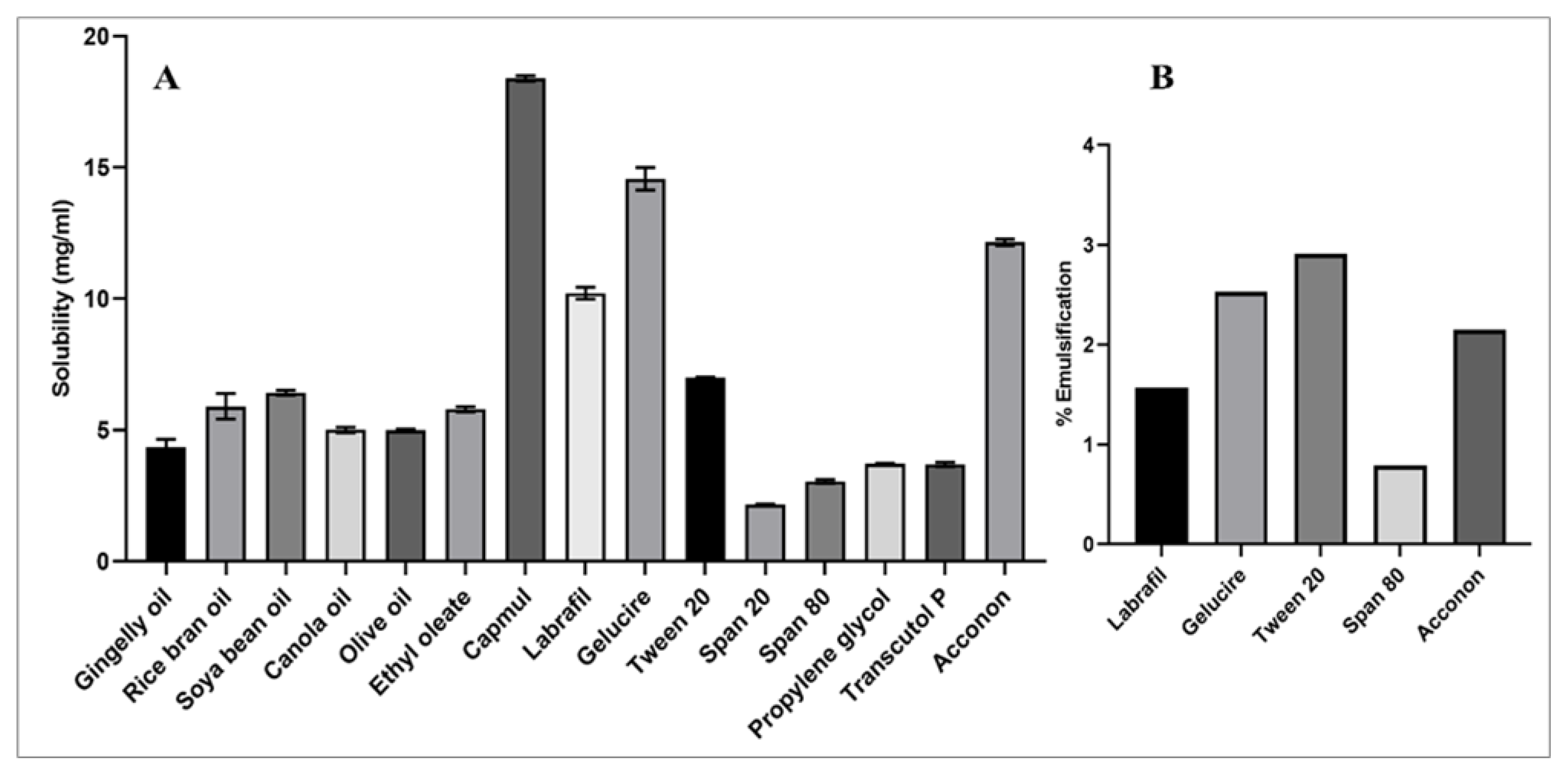
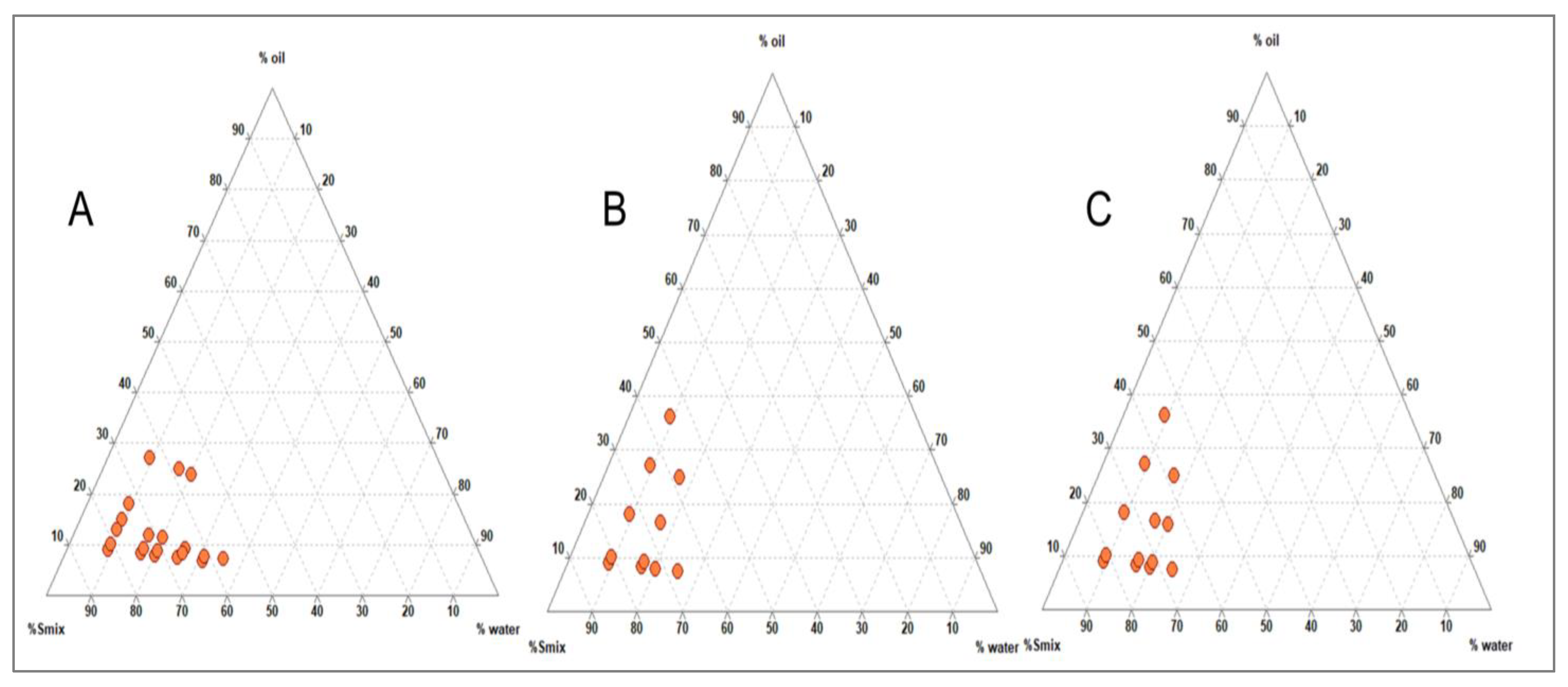
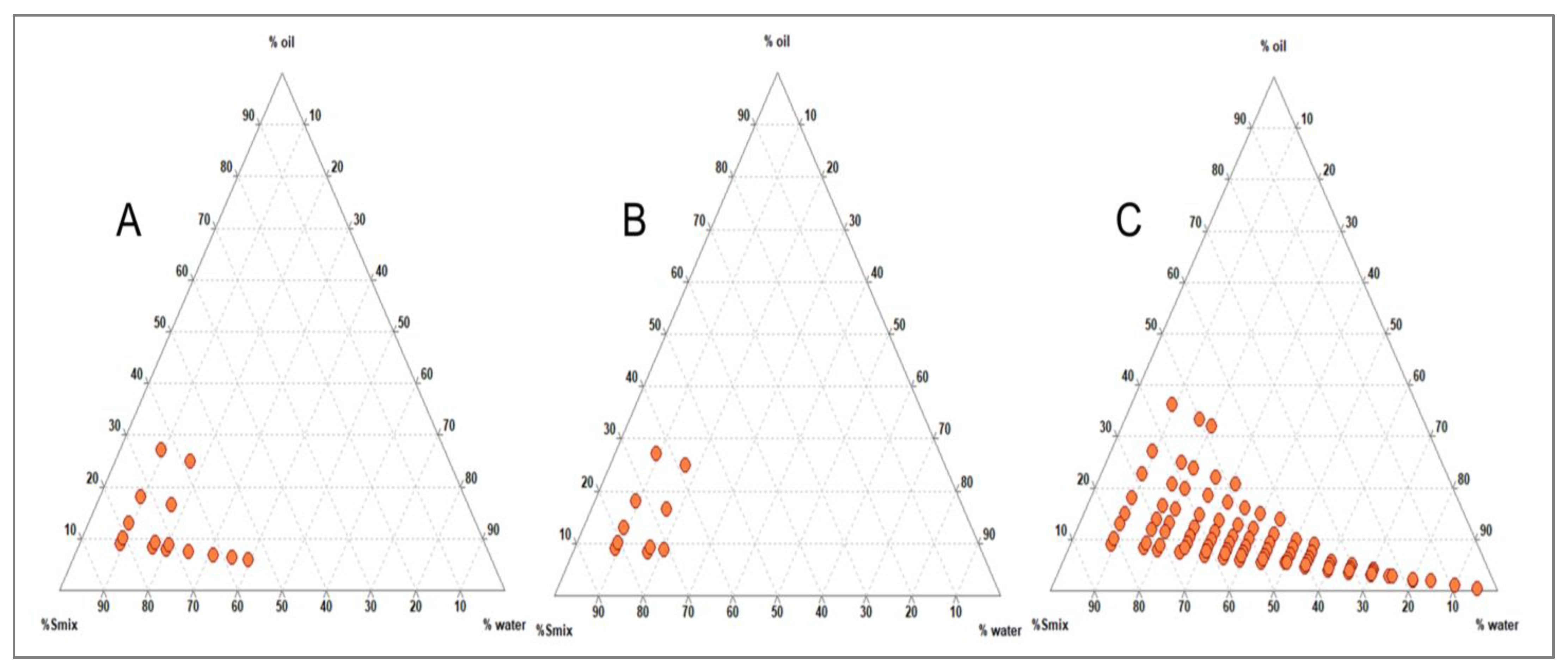
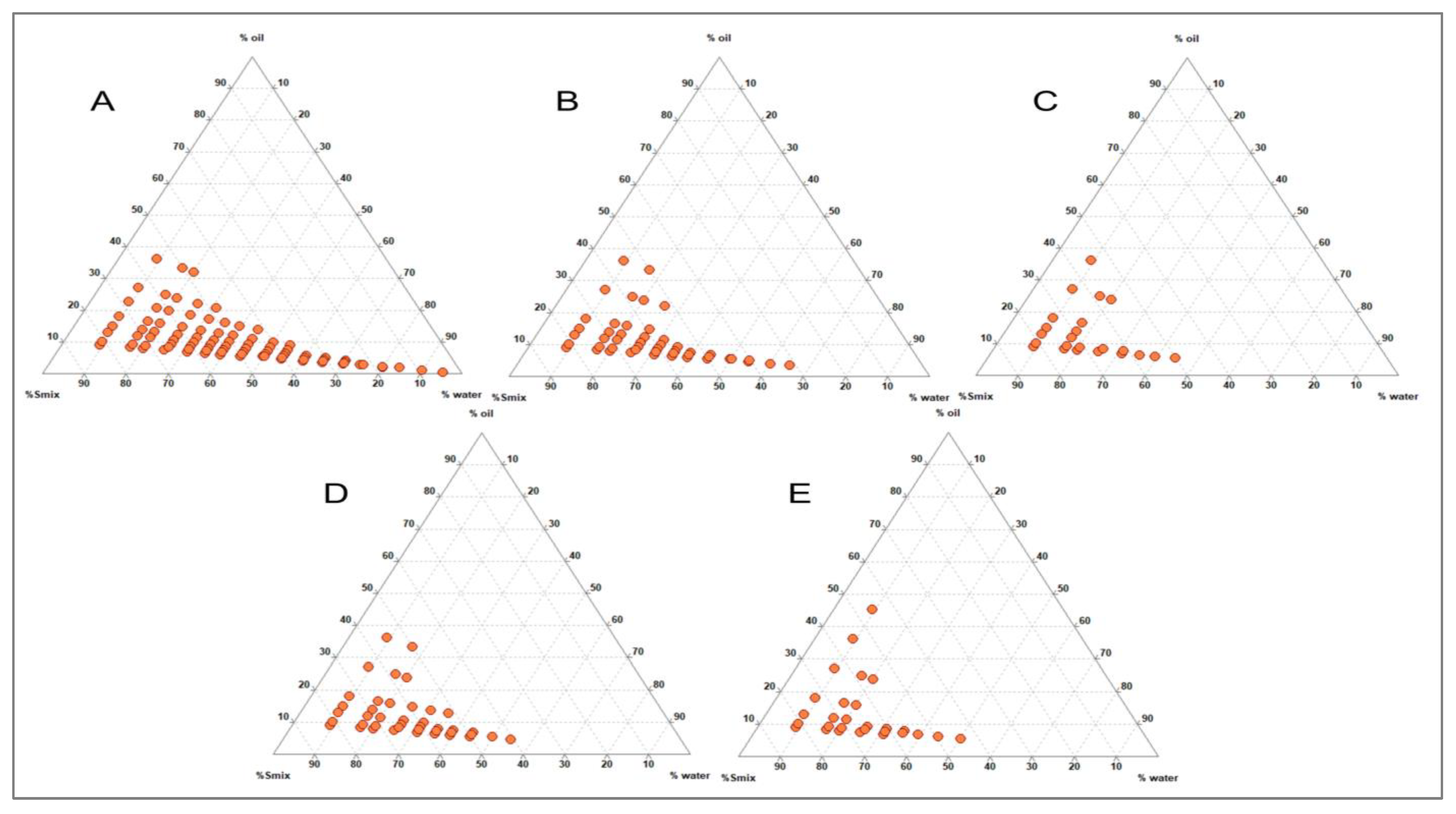
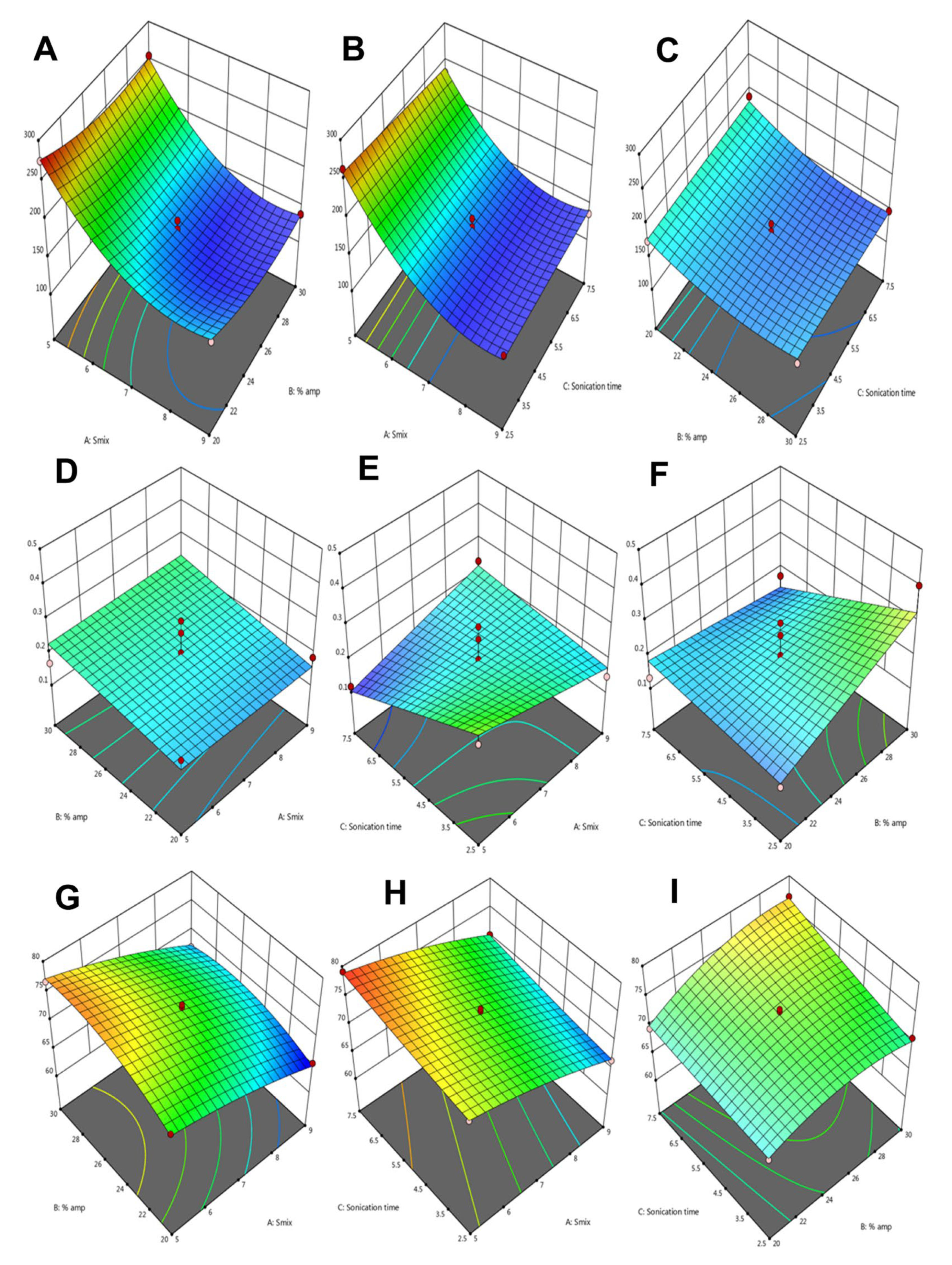
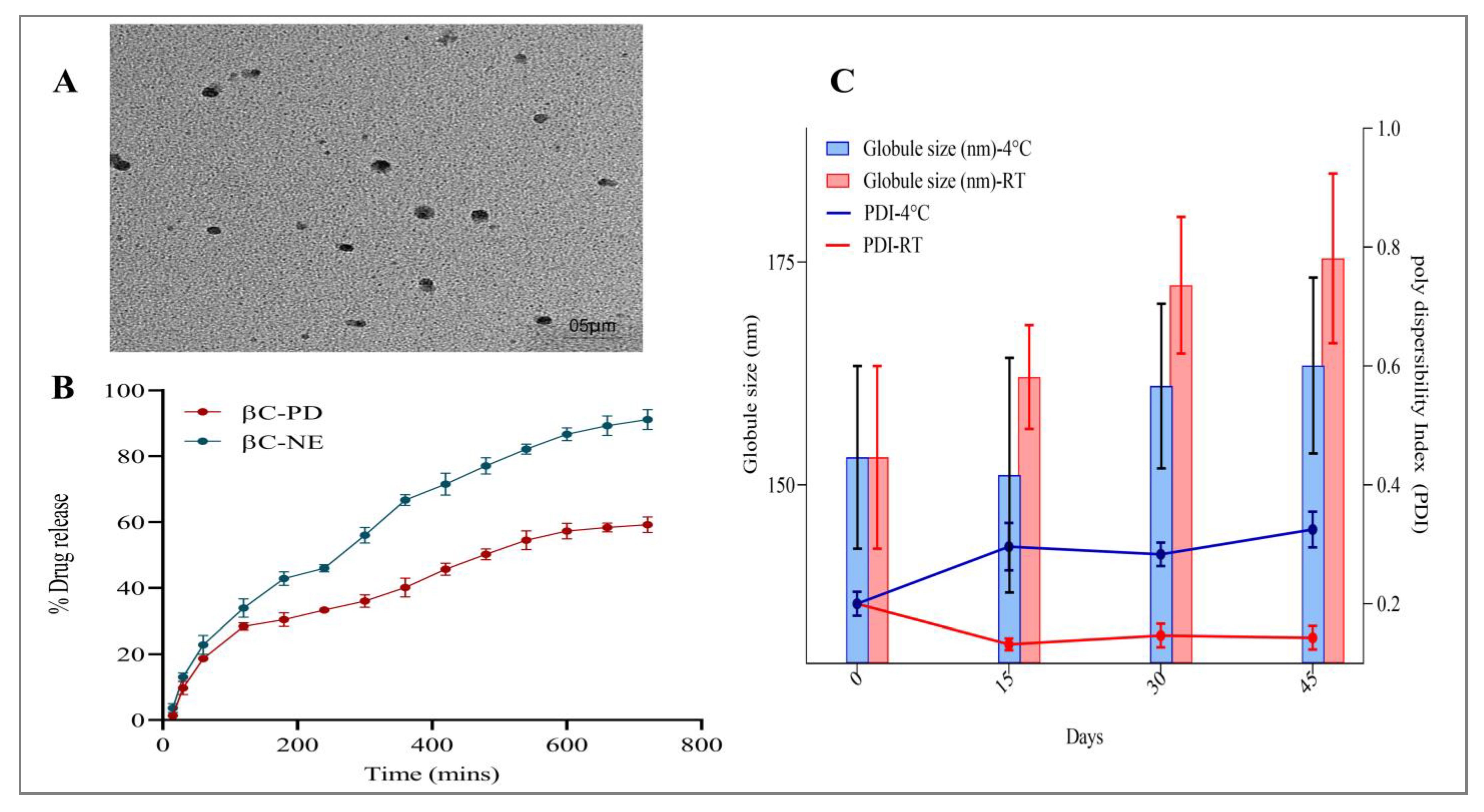
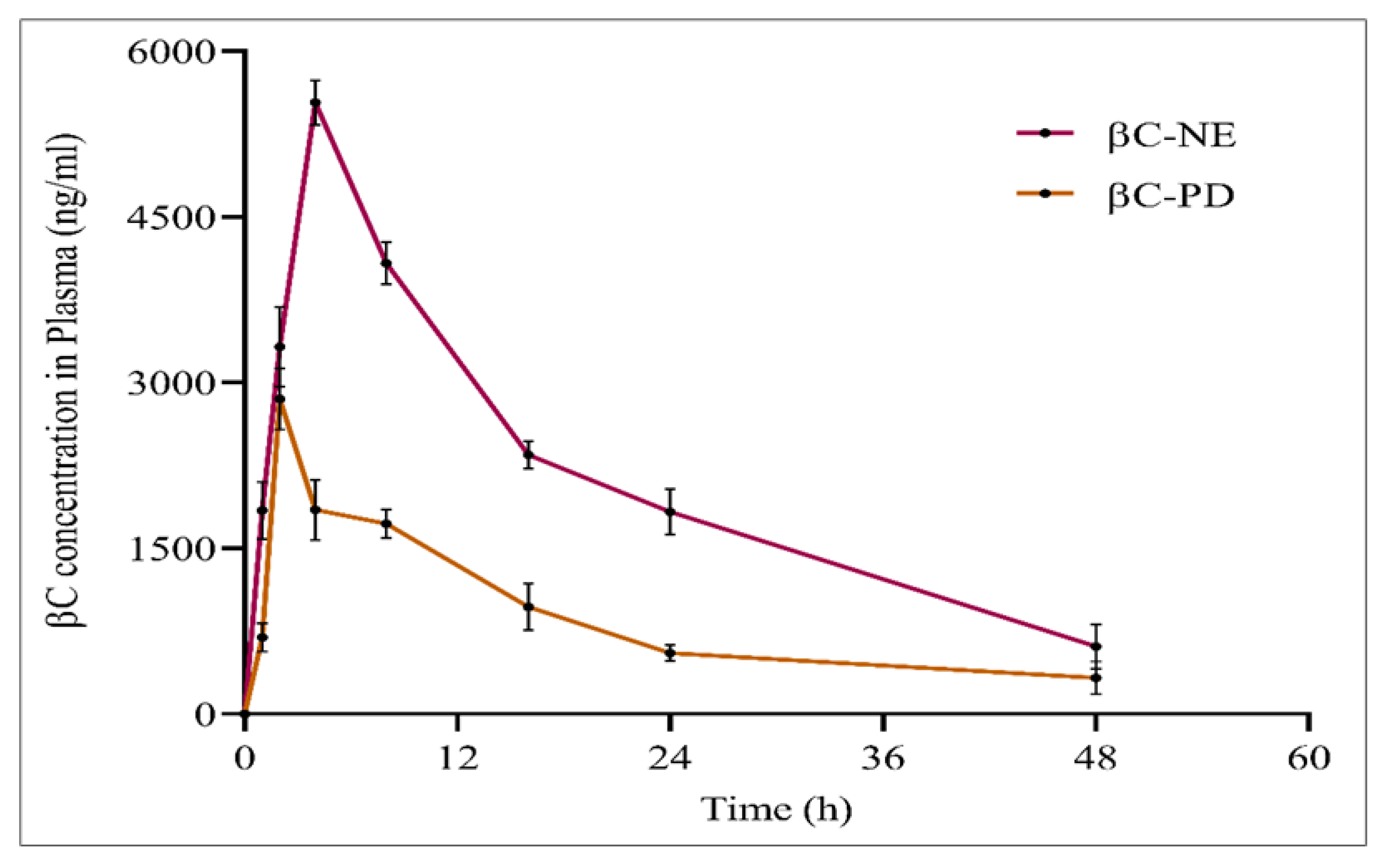
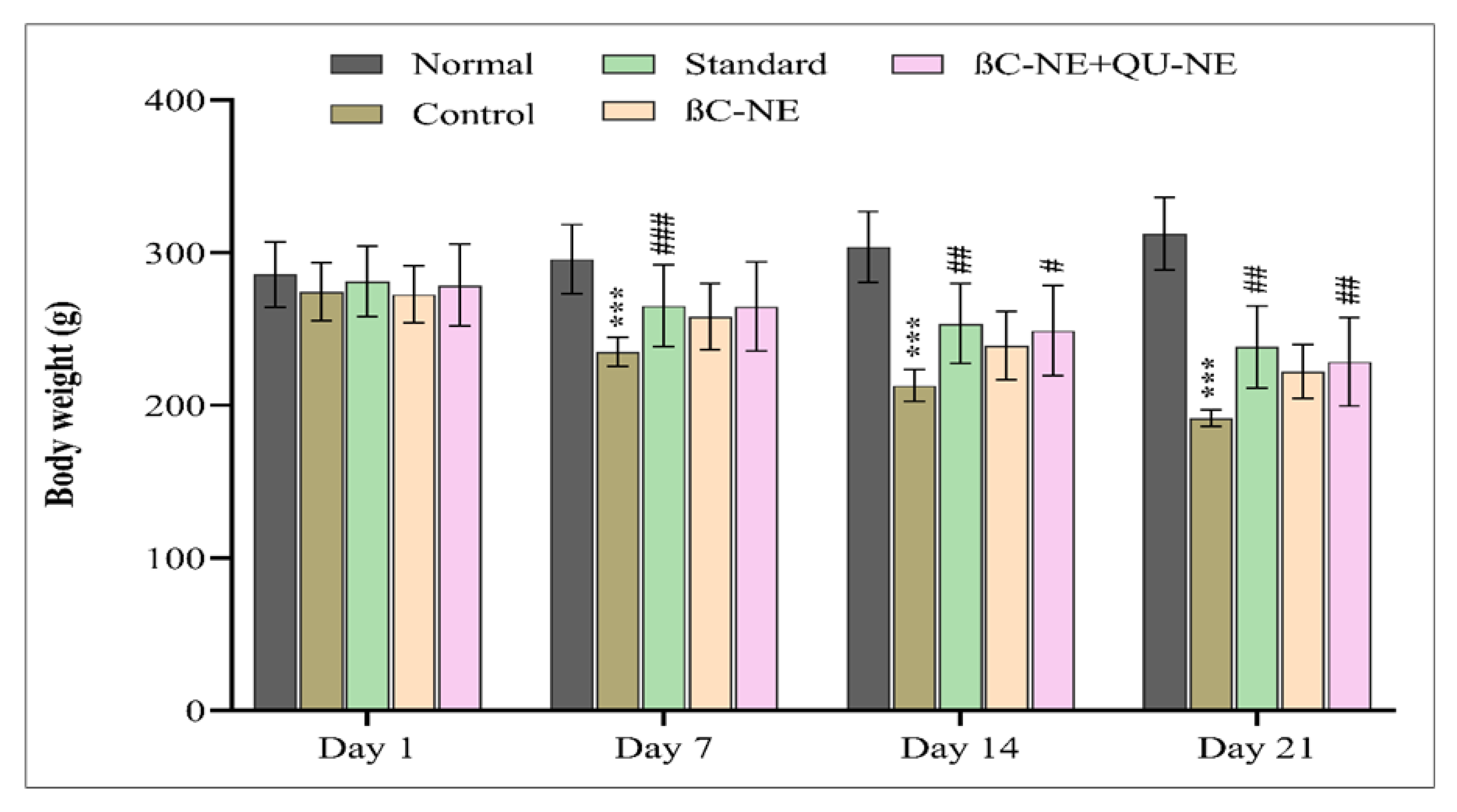
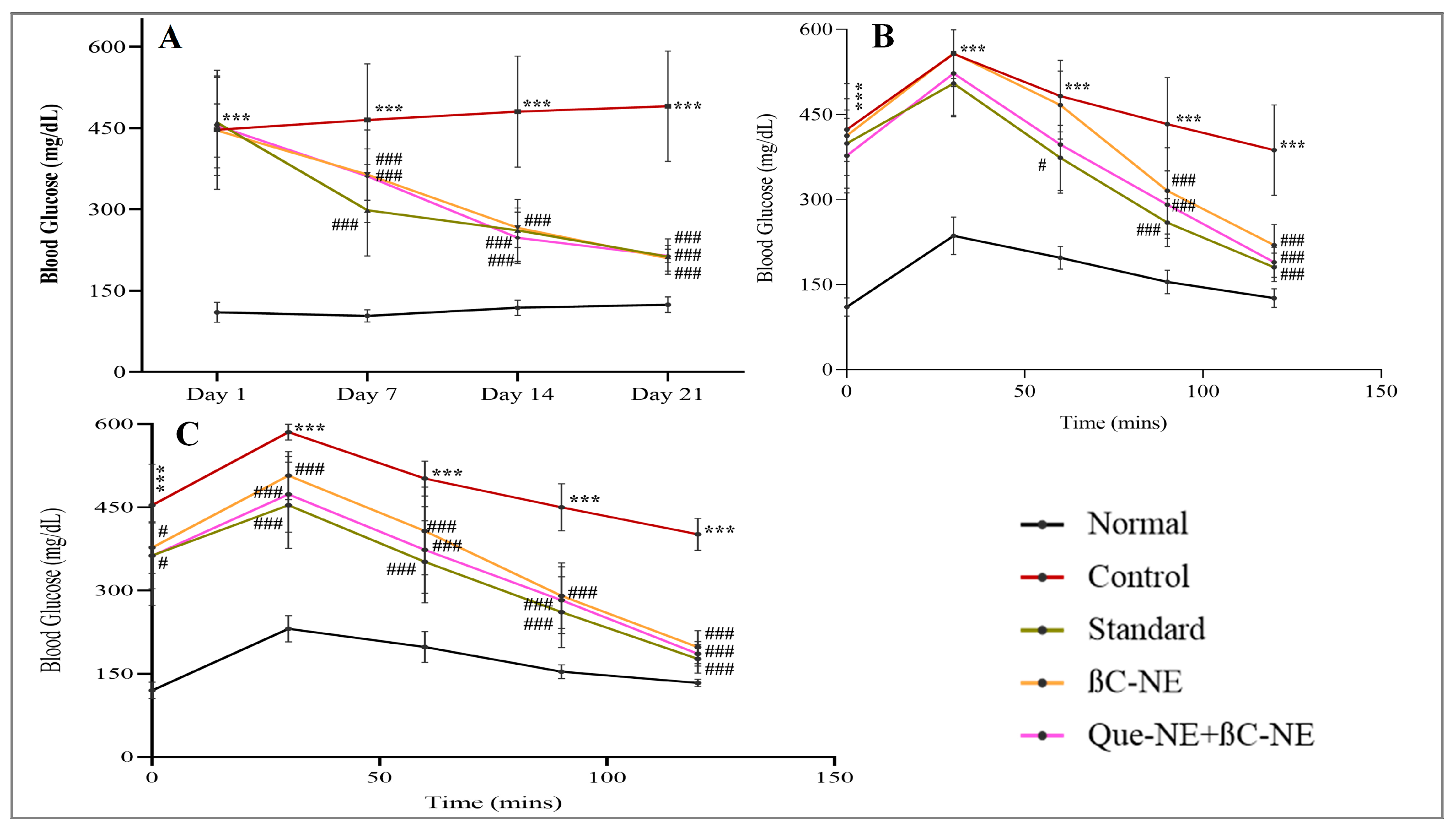
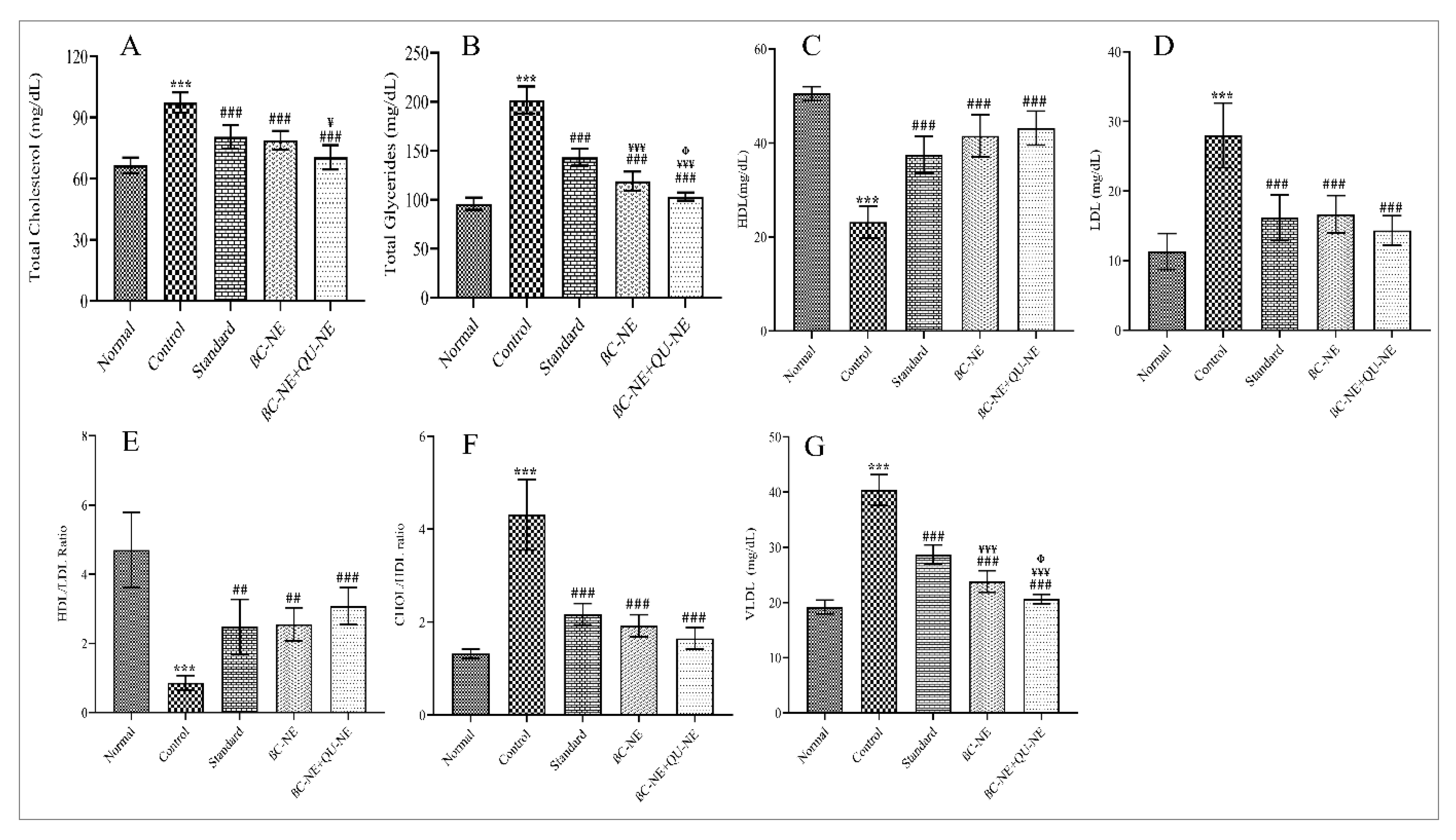
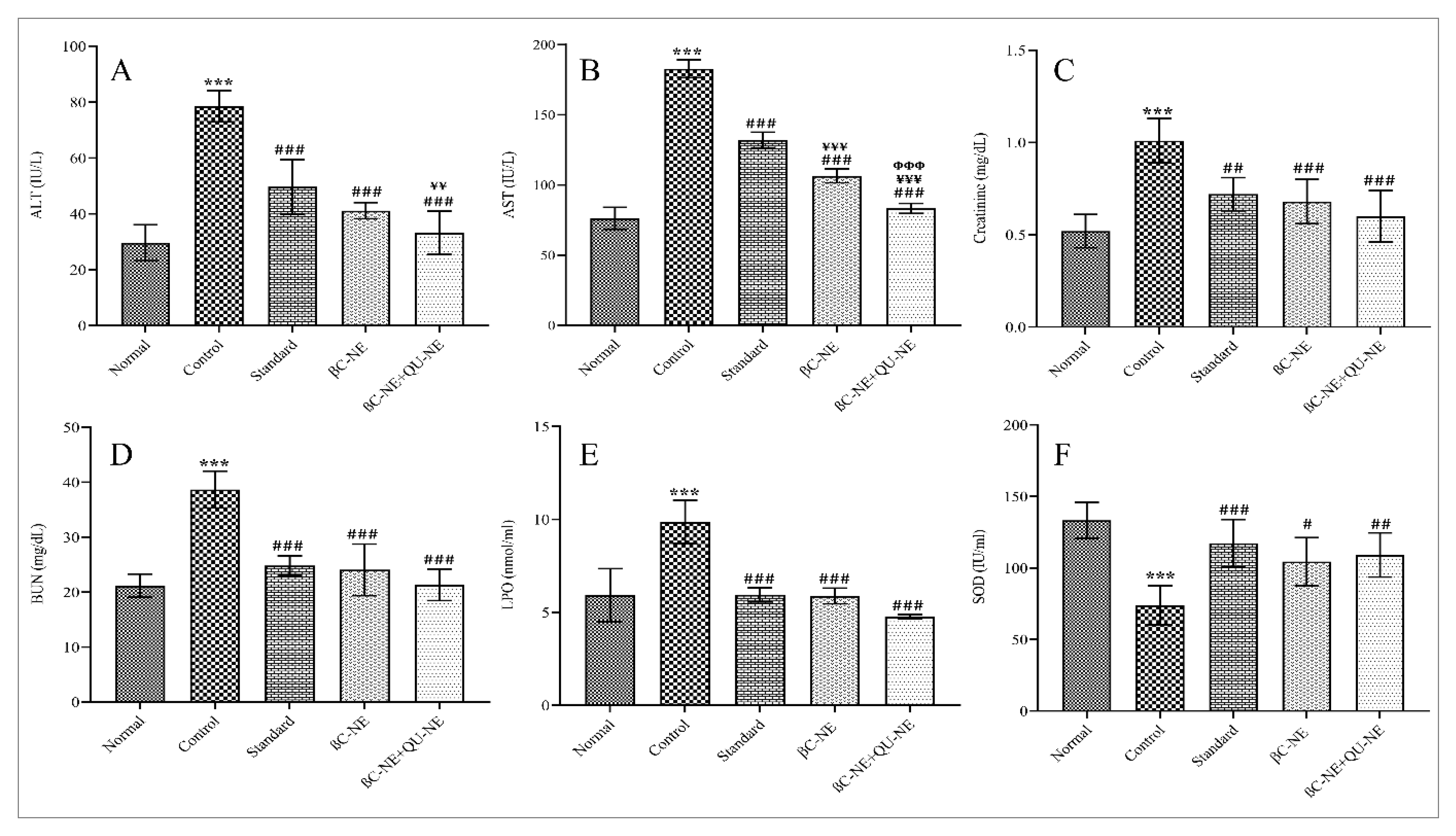
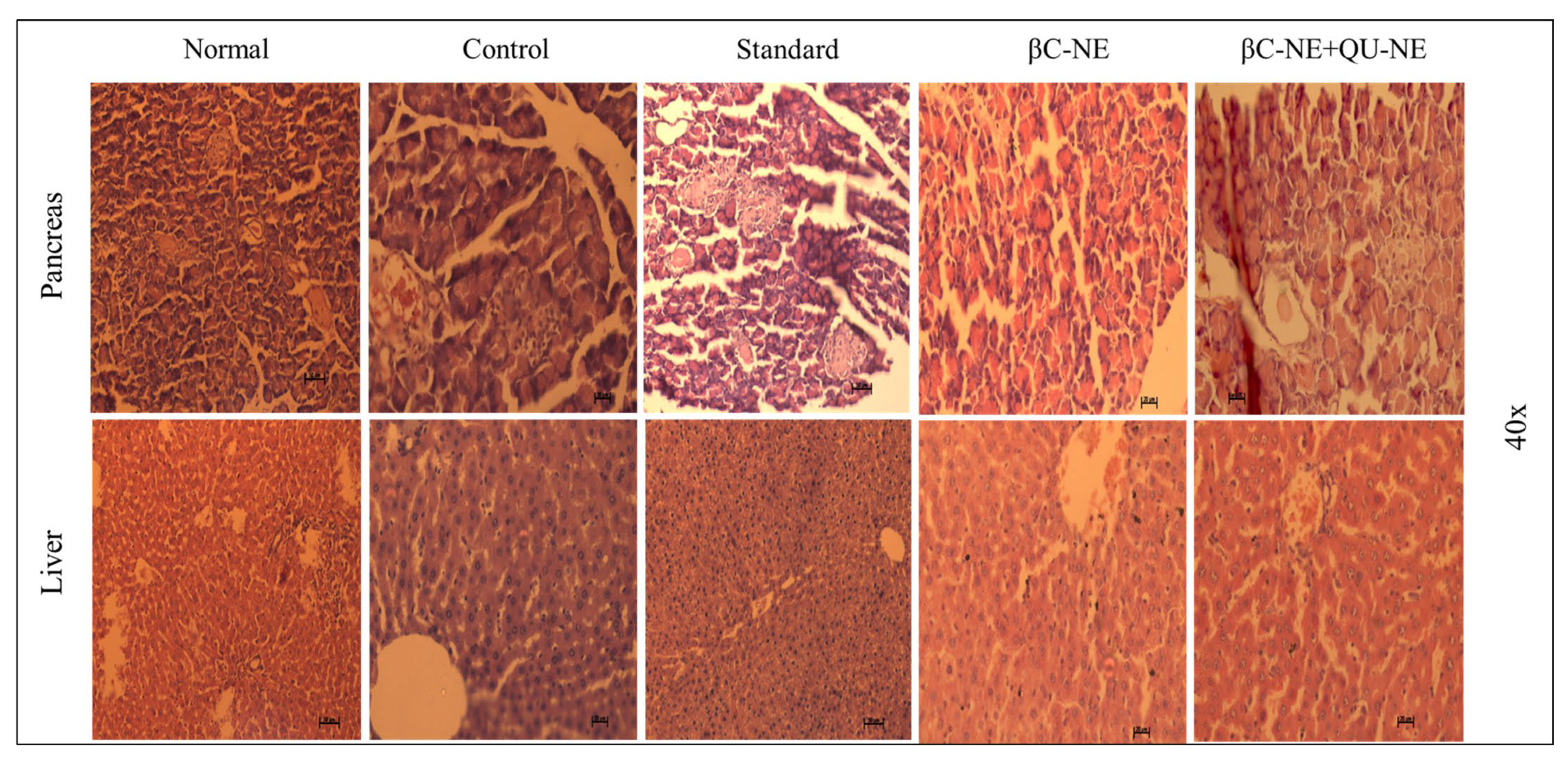
| Character | Independent Variables | Actual Levels at Coded Factor Levels | ||
|---|---|---|---|---|
| −1 | 0 | 1 | ||
| A | Smix ratio * | 5 | 7 | 9 |
| B | % Amplitude | 20 | 25 | 30 |
| C | Sonication time (mins) | 2.5 | 5.0 | 7.5 |
| Run | Independent Variables | Responses | ||||
|---|---|---|---|---|---|---|
| Smix Ratio | % Amp | Sonication Time | Globule Size (nm) | PDI | EE (%) | |
| 1 | 5 | 25 | 2.5 | 263.7 ± 16.86 | 0.269 ± 0.02 | 75.12 ± 1.08 |
| 2 | 9 | 20 | 5 | 163.7 ± 11.23 | 0.185 ± 0.03 | 65.44 ± 1.26 |
| 3 | 7 | 25 | 5 | 151.1 ± 15.43 | 0.296 ± 0.02 | 73.08 ± 0.78 |
| 4 | 7 | 30 | 2.5 | 155.0 ± 10.02 | 0.402 ± 0.05 | 70.72 ± 1.56 |
| 5 | 7 | 25 | 5 | 143.1 ± 12.25 | 0.131 ± 0.02 | 72.52 ± 2.02 |
| 6 | 5 | 30 | 5 | 255.7 ± 14.85 | 0.167 ± 0.03 | 76.68 ± 1.86 |
| 7 | 5 | 25 | 7.5 | 234.4 ± 19.92 | 0.117 ± 0.05 | 79.12 ± 2.85 |
| 8 | 7 | 20 | 2.5 | 175.4 ± 11.23 | 0.133 ± 0.02 | 68.76 ± 1.12 |
| 9 | 7 | 30 | 7.5 | 148.5 ± 10.86 | 0.172 ± 0.03 | 76.6 ± 1.56 |
| 10 | 7 | 25 | 5 | 165.0 ± 09.14 | 0.138 ± 0.02 | 72.92 ± 2.33 |
| 11 | 9 | 25 | 2.5 | 139.8 ± 08.44 | 0.147 ± 0.04 | 66.48 ± 2.42 |
| 12 | 5 | 20 | 5 | 274.8 ± 17.65 | 0.199 ± 0.02 | 72.6 ± 1.61 |
| 13 | 7 | 20 | 7.5 | 190.4 ± 15.25 | 0.131 ± 0.03 | 69.48 ± 2.84 |
| 14 | 9 | 25 | 7.5 | 136.9 ± 12.45 | 0.231 ± 0.04 | 70.32 ± 3.23 |
| 15 | 7 | 25 | 5 | 153.1 ± 13.56 | 0.200 ± 0.01 | 73.84 ± 1.82 |
| 16 | 9 | 30 | 5 | 138.8 ± 14.22 | 0.176 ± 0.02 | 67.12 ± 1.22 |
| 17 | 7 | 25 | 5 | 152.5 ± 11.45 | 0.260 ± 0.02 | 74.24 ± 1.47 |
| Source | Response 1 Droplet Size (nm) | Response 2 PDI | Response 3 %EE | |||
|---|---|---|---|---|---|---|
| ANOVA ANALYSIS | ||||||
| f-Value | p-Value | f-Value | p-Value | f-Value | p-Value | |
| Model | 54.80 | 0.0001 | 1.88 | 0.181 | 49.46 | 0.0001 |
| A-Smix | 353.26 | 0.0001 | 0.005 | 0.944 | 282.90 | 0.0001 |
| B-% Amplitude | 19.76 | 0.0030 | 0.005 | 0.9449 | 53.39 | 0.0002 |
| C-Sonication time | 0.9825 | 0.3546 | 2.67 | 0.133 | 50.55 | 0.0002 |
| AB | 0.1177 | 0.7416 | 0.031 | 0.862 | 2.79 | 0.1386 |
| AC | 2.44 | 0.1624 | 3.31 | 0.098 | 0.0124 | 0.9144 |
| BC | 1.62 | 0.2441 | 3.09 | 0.109 | 12.91 | 0.0088 |
| A2 | 98.24 | 0.0001 | - | - | 4.53 | 0.0708 |
| B2 | 12.32 | 0.009 | 36.53 | 0.0005 | ||
| C2 | 0.0005 | 0.9827 | 0.2795 | 0.6134 | ||
| Lack of fit | 1.10 | 0.4450 | ||||
| Fit statistics | ||||||
| R2 | 0.9860 | 0.5296 | 0.9845 | |||
| Adjusted R2 | 0.9680 | 0.2473 | 0.9646 | |||
| Adequate Precision | 21.95 | 5.35 | 25.312 | |||
| Regression Coefficient values | ||||||
| Intercept | 152.96 | 0.1973 | 73.32 | |||
| A-Smix | −56.17 | −0.0016 | −4.27 | |||
| B-% Amplitude | −13.29 | 0.0336 | 1.86 | |||
| C-Sonication time | −2.96 | −0.0375 | 1.80 | |||
| AB | −1.45 | 0.0057 | −0.6000 | |||
| AC | 6.60 | 0.0590 | −0.0400 | |||
| BC | −5.37 | 0.0570 | 1.29 | |||
| A2 | 40.83 | - | −0.7450 | |||
| B2 | 14.46 | - | −2.12 | |||
| C2 | −0.0925 | - | 0.1850 | |||
| Response 1 Droplet size | = + 152.96 − 56.17 × A − 13.29 × B − 2.96 × C − 1.45 × AB +6.60 × AC − 5.37 × BC + 40.83 × A2 + 14.46 × B2 − 0.0925 × C2 |
| Response 2 PDI | = + 0.1973 − 0.0016 × A + 0.0336 × B − 0.0375 × C + 0.0057 × AB + 0.0590 × AC − 0.0570 × BC |
| Response 3% E.E. | = + 73.32 − 4.27 × A +1.86 × B +1.80 × C − 0.6000 × AB − 0.0400 × AC + 1.29 × BC − 0.7450 × A2 − 2.12 × B2 +0.1850 × C2 |
| Factors | Independent Variables | Actual Levels | |
| A | Smix ratio | 7.0 | |
| B | % amplitude | 25.0 | |
| C | Sonication time (mins) | 5.0 | |
| Responses | Predicted values | Experimental values | Desirability |
| Droplet size (nm) | 152.96 | 153.1 ± 12.25 | 1.0 |
| PDI | 0.197 | 0.200 ± 0.04 | |
| E.E. (%) | 73.32 | 73.25 ± 3.25 |
| Sl.No | Pharmacokinetic Parameter | βC-PD | βC-NE |
|---|---|---|---|
| 1 | T max (h) | 2 ± 0.0 | 4 ± 0.0 |
| 2 | Cmax (ng/mL) | 2851.64 ± 274.03 | 5536.90 ± 203.486 ** |
| 3 | C48 (ng/mL) | 160.01 ± 38.93 | 612.06 ± 48.187 ** |
| 4 | T1/2 (h) | 22.54 ± 7.84 | 37.96 ± 7.74 * |
| 5 | AUC 0–48 (ng/h/mL) | 19,325.32 ± 864.26 | 94,325.65 ± 1387.50 ** |
| 6 | AUC0–∞ (ng/h/mL) | 23,345.09 ± 4231.32 | 125,784.35 ± 12,546.55 ** |
| 7 | Ke (h−1) | 0.04 ± 0.00 | 0.15 ± 0.00 * |
| 8 | Vd (mL) | 15,478 ± 3267.44 | 6634.67 ± 824.80 * |
| 9 | Cl (mL/h) | 487 ± 57.23 | 97.02 ± 7.67 * |
| 10 | MRT (h) | 29.32 ± 9.22 | 45.36 ± 8.96 * |
Disclaimer/Publisher’s Note: The statements, opinions and data contained in all publications are solely those of the individual author(s) and contributor(s) and not of MDPI and/or the editor(s). MDPI and/or the editor(s) disclaim responsibility for any injury to people or property resulting from any ideas, methods, instructions or products referred to in the content. |
© 2023 by the authors. Licensee MDPI, Basel, Switzerland. This article is an open access article distributed under the terms and conditions of the Creative Commons Attribution (CC BY) license (https://creativecommons.org/licenses/by/4.0/).
Share and Cite
Mahadev, M.; Dubey, A.; Shetty, A. Ultrasonically Fabricated Beta-Carotene Nanoemulsion: Optimization, Characterization and Evaluation of Combinatorial Effect with Quercetin on Streptozotocin-Induced Diabetic Rat Model. Pharmaceutics 2023, 15, 574. https://doi.org/10.3390/pharmaceutics15020574
Mahadev M, Dubey A, Shetty A. Ultrasonically Fabricated Beta-Carotene Nanoemulsion: Optimization, Characterization and Evaluation of Combinatorial Effect with Quercetin on Streptozotocin-Induced Diabetic Rat Model. Pharmaceutics. 2023; 15(2):574. https://doi.org/10.3390/pharmaceutics15020574
Chicago/Turabian StyleMahadev, Manohar, Akhilesh Dubey, and Amitha Shetty. 2023. "Ultrasonically Fabricated Beta-Carotene Nanoemulsion: Optimization, Characterization and Evaluation of Combinatorial Effect with Quercetin on Streptozotocin-Induced Diabetic Rat Model" Pharmaceutics 15, no. 2: 574. https://doi.org/10.3390/pharmaceutics15020574
APA StyleMahadev, M., Dubey, A., & Shetty, A. (2023). Ultrasonically Fabricated Beta-Carotene Nanoemulsion: Optimization, Characterization and Evaluation of Combinatorial Effect with Quercetin on Streptozotocin-Induced Diabetic Rat Model. Pharmaceutics, 15(2), 574. https://doi.org/10.3390/pharmaceutics15020574







